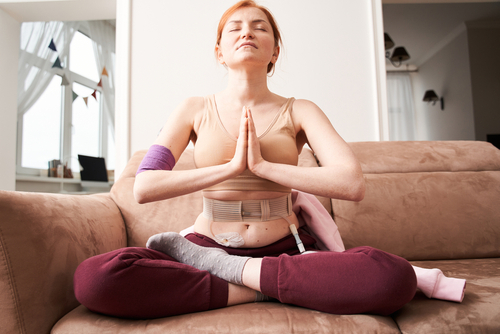Meditation is gaining popularity as a self-care wellness method. While this conscious concept may be unfamiliar or somewhat new to many, meditation dates back thousands of years. Meditation, as defined by the Cleveland Clinic, is a practice that involves focusing or clearing one’s mind using a combination of mental and, if and when possible, physical techniques. But is meditation accessible for people with disabilities?
For individuals within the disability community — perhaps especially so for those with limited mobility, chronic degenerative conditions, autism spectrum disorder and other conditions — meditation may boast significant benefits.
Making Meditation Accessible Is Doctor’s Orders
Dr. Rex Marco is a surgeon specializing in spine surgery and orthopedic oncology. As a world-renowned physician and the father of four, his schedule is undoubtedly busy! Still, he made the deliberate decision to parlay his passion for meditation into a second profession — completing the Mindfulness Meditation Teacher Certification Program. He was motivated to do so because, he attests, that meditation is essential to his well-being. Furthermore, he credits meditation as instrumental to his recovery journey following a C3 spinal cord injury.
“Meditation became a part of my life in the fall of 2015 when I was experiencing a lot of emotional pain in my life,” Dr. Marco tells AmeriDisability. He was led to the book titled The Wisdom of Insecurity by Alan Watts. “This book introduced me to the practice of mindfulness, which I currently define as nonjudgmental, loving awareness of senses in the present moment.”
Next, he read the book This Moment is Full of Wonders by Thich Nhat Hanh. “I began starting my day meditating on his calligraphy work. One page would say “Breathe,” and another page would say “Breathe, my dear” and yet another page would say ”Listen,” Dr. Marco recalls. “Sitting at the side of my bed, in silence, helped me be present in those moments before getting ready to start my day.”
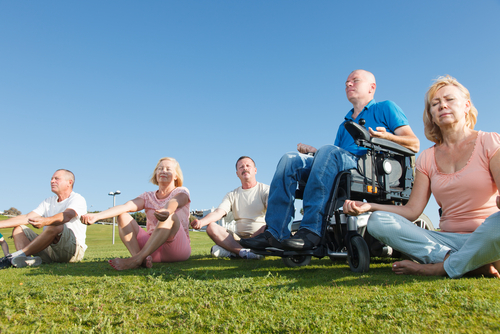
Dr. Marco tells AmeriDisability that he was suffering from numerous stress-related conditions before initiating meditation, including pre-diabetes, hypertension, insomnia, unrecognized stress, anxiety and depression. “I was able to treat all of these conditions once I started meditating,” the Houston-based physician asserts!
Then, in 2019, Dr. Marco, an avid mountain biker, set out a nature trail for a mindful ride. However, on that day, he hit a branch and his life was uprooted by paralysis. Because of his ironically-precise medical expertise, he immediately took an active role in his treatment – instructing bystanders on first aid, reviewing his own diagnostic test results and collaboratively developing the surgical plan that his colleagues would perform.
In recovery, Dr. Marco reminded himself to tap into meditation, as he had so often advised at the bedside of his patients. You see, studies show that meditation can decrease stress, anxiety and pain, as it did for Dr. Marco, while also increasing relaxation, memory and clarity, among other benefits. Psychology Today writes that “meditation acts on areas of the brain that modulate the autonomic nervous system, which governs such functions as digestion and blood pressure—functions heavily affected by chronic stress. Through its physiological effects, meditation has been found to effectively counter heart disease, chronic pain and other conditions. It is also valuable in improving emotion regulation.” In general, the meditative mind can help one achieve a sense of control to combat mental and physical discomfort.
How to Make Meditation Accessible
There are several types of meditation, such as guided meditation, mantra meditation and transcendental meditation, to name a few. Meditation forms often emphasis breath and body awareness. However, because of his paralysis, Dr. Marco discovered he couldn’t access full sensation from standard practices like he previously did during meditation.
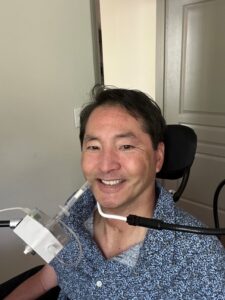
“I lost my ability to use my breath as my primary anchor after my accident,” he explains. “Thankfully, my sense of hearing became my primary anchor and it allows me to ground whenever I become aware of sound.”
Meditation apps, commonly used by meditators of all abilities and skill levels, aren’t always inclusive for people with disabilities. A Mashable article summarized the inequality by explaining: “For people with disabilities, standard meditation fare can seem exclusionary. Meditation resources—apps, online courses, in-person classes—often make assumptions about the person meditating. A basic set of misguided assumptions: that they can walk, see, hear or feel.”
It’s fair to say that one, traditionally designed app won’t work for all. But companies are starting to embrace accessible features.
“Our mission is to create a world where everyone is kind to their mind — which is why we’re committed to making our mobile products more accessible for every person, regardless of their visual, auditory, cognitive or motor abilities,” Hannah Foley, Corporate Communications Manager for Headspace Health, tells AmeriDisability.
Headspace is among the most downloaded meditation apps. “We’ve prioritized trainings with our team to ensure that we are designing for disability, meaning that we consider impairments that affect everyday activities, including software/device use and physical space navigation,” Foley added.
Headspace has advanced its accessibility features over the years to implement:
- Closed captions for all in-app content
- Haptic feedback to enhance experience for visually impaired users
- Text scaling
- Support for all screen widths and orientations (landscape mode)
- Screen reader supports (considering focus order)
- Color contrast (to improve readability and usability of design)
- Audio descriptions for videos
And that’s not all. “Separately, as part of this commitment, we’ve partnered with Perkins Access, a division of Perkins School for the Blind, to ensure that our platform conforms to the World Wide Web Consortium’s Web Content Accessibility Guidelines (W3C WCAG) Version 2.1 Level AA requirements to the maximum extent possible,” Foley shares. “These guidelines explain how to make web content more accessible for people with disabilities. Perkins Access provides us with user and expert reviews, ongoing accessibility support, Accessibility Conformance Reports/Voluntary Product Accessibility Templates (VPATs) and expert standards guidance.”
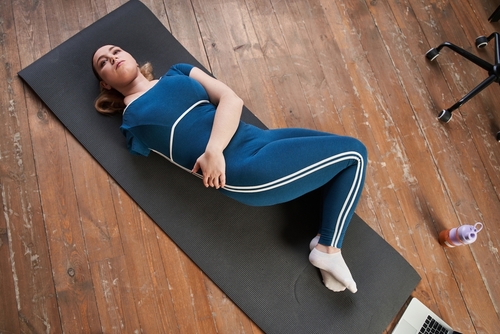
The product and design staff at Headspace, Foley says, are required to complete self-paced Web Accessibility Learning Paths that outline several topics, including:
- The top 51 best practices and strategies for designing for accessibility;
- Accessible color contrast and color independence;
- Accessible wording;
- Accessible styling;
- Designing accessible charts, graph and other data visualizations; and
- Accessible interaction states (focus, hover, etc.).
AmeriDisability reached out to other meditation apps, including Calm and Ten Percent Happier; neither responded to our inquiries about accessibility. Other sources, such as YouTube, may also offer additional features, such as ASL-interpreted mediation.
Accessibility Tips for Beginner Meditation
People with ADD/ADHD, autism spectrum disorder or other neurodiverse conditions often assume that meditation is beyond their mental reach. But Dr. Marco disagrees.
“I believe one misconception regarding meditation (that is common to those with and without limited mobility or a disability) is that there is a ‘need’ to quiet the mind while meditating. It is true that some forms of meditation do engage in the practice of quieting the mind. However, mindfulness meditation or insight meditation engages in the practice of understanding that the mind thinks and emotes while the body feels, listens, sees, tastes and smells. Learning that it is normal for the mind to think even while meditating was helpful for me to continue practicing mindfulness meditation,” he shares.
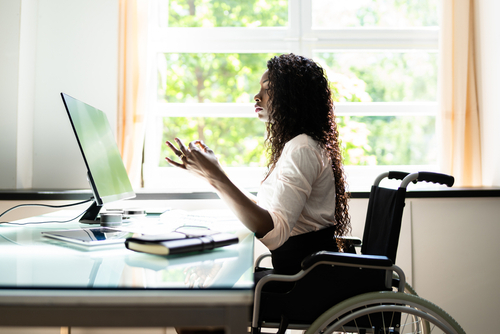
Tactics to Make Meditation Accessible
- Distractions happen. If and when the mind wanders to unwanted thoughts, strive to regain focus.
- There’s no wrong way to meditate. Practice is varied and personal. And one’s approach to meditation may change over time.
- Begin with brief three-to-five-minute sessions and build. Consistent practice is more important than how much time is devoted daily.
- If one form of meditation doesn’t fit, try another type.
- Choose a comfortable position, especially if the traditional crossed-legged stance isn’t ideal. One can meditate in a wheelchair, lying on a bed, while taking a walk, during a yoga session and so on. One may also close the eyes or focus on a calming object.
- Some opt to practice in the same, designated space (perhaps with a meditation pillow). Consider incorporating other relaxation elements into the environment too, like fragrance oils or candles and soft lighting.
- If desired, explore technology-assisted meditation; from guided apps to pulsed electromagnetic field (PEMF) devices.
- It takes time to master meditation skills. And benefits may not happen overnight! Grant yourself some grace.
Teaching Meditation for All
Dr. Marco, now 58, summarizes: “I have used mindfulness meditation during my entire recovery from the moment of my accident until the present moment, to help remind me to live in this moment rather than worry about the future or dwell on the past.” And living he is! Dr. Marco is practicing medicine, giving lectures and teaching meditation to colleagues and students of all abilities.
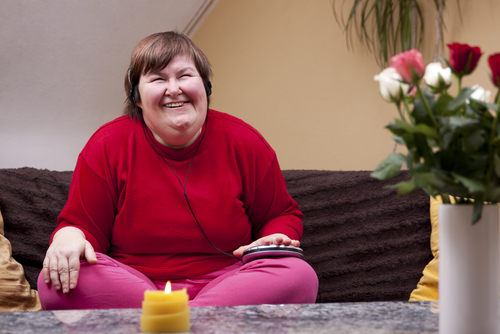
“I teach meditation for Gathering Strength, which is an organization whose mission is to empower people with physically disabling conditions by ensuring equitable access to community resources and spaces, technology and better health,” Dr. Marco says. “I also incorporate mindfulness meditation into most of my speaking engagements and teach my spine surgery fellows and residents mindfulness meditation as a stress reduction and burnout prevention technique.”
In his spare time, Dr. Marco reads, plays with his kiddos and enjoys nature. He most recently enjoyed an adaptive skiing adventure.
So, are you ready to meditate? You can do it!




